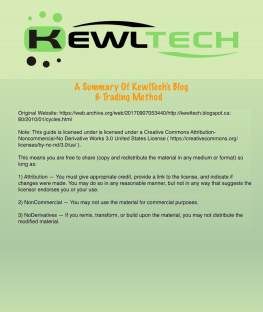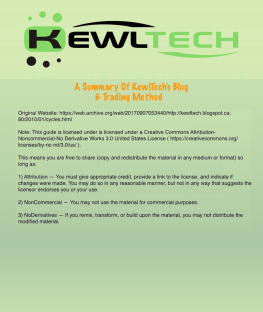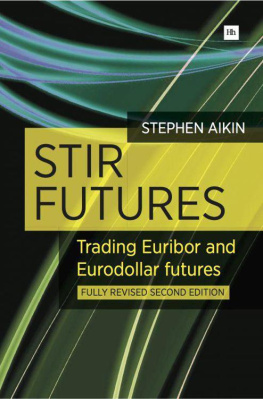Kewltechs Technical Trading Blog Course
Technical Analysis. The only way to trade. Focusing primarily on S&P E-Mini. With some stocks to demonstrate proper use of technical analysis of the markets. The charts and comments herein are based out of my technical analysis. Trade at your own risk. ISSN 2153-6295 2009-2013
Note: This e-book and related files are licensed under a Creative Commons Attribution-Noncommercial-No Derivative Works 3.0 United States License. You may share this book so long as you give credit to Kewltech, and you are not permitted to resell, or modify the document for commercial or financial gain.
How To Learn : First watch the 4 videos (see below) as they are examples of how people trade Kewltech style. This first video in this series gives a general idea of the the technique used. Videos 2-4 go into more detail, and provide more examples. Then go through the .
To download all the vids: https://mega.nz/#F!v3AVnKBS!6eFT7YGcDww0aT-MTuBTNg
Mirrors: 1) https://www.bitchute.com/video/auu3PVRsgl0e 2) https://www.bitchute.com/video/A0fGD5F7AWg3 3) https://www.bitchute.com/video/uS1sFCSXGzGu 4) https://www.bitchute.com/video/wKz5jlZ6ZpaP
FOR MORE INFORMATION AND EXAMPLES SIGN UP AND MAKE AN ACCOUNT AT:
https://futures.io/emini-index-futures-trading/37023-price-action-kewltech-style.html You need to register for free to see the images in the thread. You should also hit the 'USER CP' button -> Edit Options -> and change number of posts to show per page to 40. The thread discusses KewlTech's Method and is one of the more popular & active threads in this forum. It is advised to go through the posts of the thread contributors from beginning to end of the thread.
Introduction
Markets moves from support lost to support gained and vice versa. Watch how markets react to levels. In every single time frame. Learn to put the time frames together. Learning momentum, distribution, accumulation, legs, proper support and resistances are key. You'll get the hang of it if you are persistent :)
Issue 1/89 Cycles
Kewltech is going circle of life thing. Cue the music Elton! NOT!
As you can see, I really only use 2 oscillators . I used to use RS Wilder but essentially it took too much chart space and became obsolete. Well, not obsolete, but redundant.
What are oscillators used for?
Generally, they are momentum indicators. They also tell you when something is overbought or oversold. Some people use them to tell them when to buy and sell. There are a host of indicators and I've never aimed to use them all. I became well acquainted with 2 indicators and those are my MACD and Slow Stochastic.
MACD StockCharts.com Definition - Developed by Gerald Appel, Moving Average Convergence/Divergence is one of the simplest and most reliable indicators available. MACD uses moving averages, which are lagging indicators, to include some trend-following characteristics. These lagging indicators are turned into a momentum oscillator by subtracting the longer moving average from the shorter moving average. The resulting plot forms a line that oscillates above and below zero, without any upper or lower limits. MACD centered oscillators apply.
As a momentum indicator, MACD has the ability to foreshadow moves in the underlying security. MACD divergences can be key factors in predicting a trend change. A Negative Divergence signals that bullish momentum is waning, and there could be a potential change in trend from bullish to bearish. This can serve as an alert for traders to take some profits in long positions, or for aggressive traders to consider initiating a short position.
Stochastic Slow StockCharts.com Definition - Developed by George C. Lane in the late 1950s, the Stochastic Oscillator is a momentum indicator that shows the location of the current close relative to the high/low range over a set number of periods. Closing levels that are consistently near the top of the range indicate accumulation (buying pressure) and those near the bottom of the range indicate distribution (selling pressure).
I suggest you visit StockCharts.com and read up on these 2 old school indicators.
These 2 indicators compliment each other. One is known as a lagging indicator (MACD) and the other is known as leading indicator (Stochastic). I think the term leading indicator is a bit of a stretch when it comes to indicators. It is a matter of perspective and interpretation. Yadi yadi ya. To use these indicators effectively, you have to understand the cycles they run.
Both of these indicators have 2 lines that crisscross each other. Both have fast and slow lines. When the fast line is above the slow line, it is known to be in POSITIVE DIVERGENCE. When the slow line is above the fast line, it is known to be in NEGATIVE DIVERGENCE. At the point where the fast and slow line meet, it is known to be in CONVERGENCE.
When I use the terms Positive and Negative Divergences. I only mean these cycles and not the divergences between peaks as some are known to trade. It is a matter of perspective and interpretation. Yadi yadi ya.
Cycle is always this:
Convergence -> Pos Divergence -> Convergence -> Neg Divergence -> Convergence -> Pos Divergence -> Convergence -> Neg Divergence ... at infinitum.
The MACD loops through these cycles in a generally cleaner fashion than the stochastics. It is easier to discern the cyclic nature than the often-wild frenzy of the stochastics. Regardless, the said cycles above are respected.
Price Action and Cycles
Imagine a clock. Imagine that these 2 oscillators actually travel in clean circles. And the point of interest is the tip of the fast line of both oscillators.
Convergence is always at 9 o'clock. Price Action on Pos Divergence:
9 o'clock -> 12 o'clock pos price action
12 o'clock -> 3 o'clock neg price action
Convergence
Price Action on Neg Divergence:
9 o'clock -> 6 o'clock neg price action
6 o'clock -> 3 o'clock pos price action
Why do these cycles exist?
Simply they describe incoming volume. On pos divergence, generally the bulk of volume coming in are bullish and then tapers off and becomes more bearish cycling you to the next cycle of neg divergence. What do you mean coming in? Well in order for these things to work, it needs input. The math to produce the charts and the oscillators need input data. In this case volume of orders for buy or sell. Knowing this, how can an oscillator or indicator be leading if it relies only on data that has come in and doesn't actually represent what will come in? It is a matter of perspective and interpretation. Yadi yadi ya. LOL.
The cycles describe the incoming data. Hmmm
Pos Divergence "generally the bulk of volume coming in are bullish" ... "generally" meaning there is some bearish volume in there. Hmmm... Ergo Neg Divergence should have some bullish volume too.
Oh that makes sense because this produces the range of the candles. And even there is a rally there are moments of pause where we get a red candle too. Oh!!
As mental midget would say..."Imagine that."
Take a few to digest the concepts above and then later on we will move on to build on this. Elton... your turn.
Issue 2/89 Accumulation
Accumulation StockCharts.com Definition - The act of buying more shares of a security without causing the price to increase significantly. After a decline, a stock may start to base and trade sideways for an extended period. While this base builds, well-informed traders and investors may seek to establish or increase existing long positions. In that case, the stock is said to have come under accumulation.




![Hart-Davis - Teach yourself visually Android phones and tablets, [2015]](/uploads/posts/book/212223/thumbs/hart-davis-teach-yourself-visually-android-phones.jpg)









